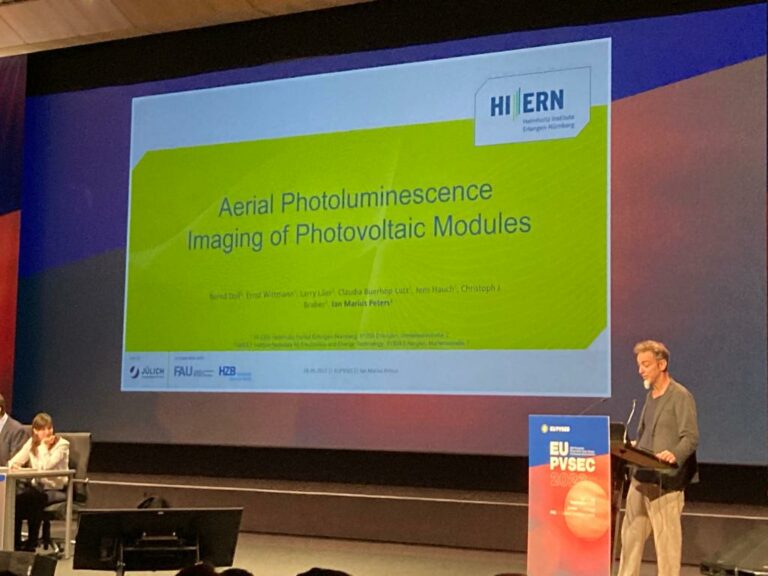We’re thrilled to introduce a groundbreaking innovation that’s set to redefine the way we inspect photovoltaic (PV) modules: Aerial Photoluminescence Imaging, or PLAI. Developed by Marius Peters, Larry Lüer and Christoph Brabec from FAU Solar, this cutting-edge technology was showcased at PVSec, leaving us in awe of its potential.
Taking PV Inspection to New Heights: PLAI leverages the power of hexacopter drones equipped with Near-Infrared (NIR) cameras and specialized illumination units. This breakthrough enables contact-free, high-throughput, and cost-effective inspection of PV modules in real-world conditions.
The Power of Photoluminescence: Photoluminescence imaging is at the heart of PLAI. While this technique has proven effective in the lab, its application in aerial imaging presented unique challenges, including the need to mount a light source on the drone and detect module defects under varying light conditions.
The PLAI Setup: The PLAI setup consists of a hexacopter aerial drone equipped with an illumination unit and a NIR camera. This unit can partially illuminate full-sized modules at night while capturing the photoluminescence response. During its maiden flight, PLAI achieved an impressive throughput of 13.6 PV modules per minute, with a potential throughput of 300 PV modules per minute. This level of efficiency is a game-changer for the PV industry.
Identifying Module Defects: PLAI is not just about speed; it’s about accuracy. This innovative system can reliably detect and identify a range of defects, including cracks, shunts, and potential-induced degradation (PID), with high confidence levels. These findings are validated through cross-correlation and comparison with electroluminescence images taken indoors.
Overcoming Challenges: One key challenge in drone-mounted PLAI is the partial and nonhomogeneous illumination of modules under low irradiance. This results in the superposition of excitation and response, altering the spatial intensity distribution of light emitted by solar cells compared to laboratory conditions. Despite this challenge, PLAI has demonstrated its capability to identify module defects effectively.
What’s Next: Marius Peters and the @SolarFAU team are continuously pushing the boundaries of PV inspection technology. By optimizing PLAI’s capabilities and addressing challenges, they’re poised to transform the way we ensure the quality and efficiency of PV modules.
To dive deeper into this revolutionary technology and its implications for the PV industry, read Marius’, Larry’s and Christoph’s publication.
Follow us on X.

We’re thrilled to introduce a groundbreaking innovation that’s set to redefine the way we inspect photovoltaic (PV) modules: Aerial Photoluminescence Imaging, or PLAI. Developed by Marius Peters, Larry Lüer and Christoph Brabec from FAU Solar, this cutting-edge technology was showcased at PVSec, leaving us in awe of its potential.
Taking PV Inspection to New Heights: PLAI leverages the power of hexacopter drones equipped with Near-Infrared (NIR) cameras and specialized illumination units. This breakthrough enables contact-free, high-throughput, and cost-effective inspection of PV modules in real-world conditions.
The Power of Photoluminescence: Photoluminescence imaging is at the heart of PLAI. While this technique has proven effective in the lab, its application in aerial imaging presented unique challenges, including the need to mount a light source on the drone and detect module defects under varying light conditions.
The PLAI Setup: The PLAI setup consists of a hexacopter aerial drone equipped with an illumination unit and a NIR camera. This unit can partially illuminate full-sized modules at night while capturing the photoluminescence response. During its maiden flight, PLAI achieved an impressive throughput of 13.6 PV modules per minute, with a potential throughput of 300 PV modules per minute. This level of efficiency is a game-changer for the PV industry.
Identifying Module Defects: PLAI is not just about speed; it’s about accuracy. This innovative system can reliably detect and identify a range of defects, including cracks, shunts, and potential-induced degradation (PID), with high confidence levels. These findings are validated through cross-correlation and comparison with electroluminescence images taken indoors.
Overcoming Challenges: One key challenge in drone-mounted PLAI is the partial and nonhomogeneous illumination of modules under low irradiance. This results in the superposition of excitation and response, altering the spatial intensity distribution of light emitted by solar cells compared to laboratory conditions. Despite this challenge, PLAI has demonstrated its capability to identify module defects effectively.
What’s Next: Marius Peters and the @SolarFAU team are continuously pushing the boundaries of PV inspection technology. By optimizing PLAI’s capabilities and addressing challenges, they’re poised to transform the way we ensure the quality and efficiency of PV modules.
To dive deeper into this revolutionary technology and its implications for the PV industry, read Marius’, Larry’s and Christoph’s publication.
Follow us on X.